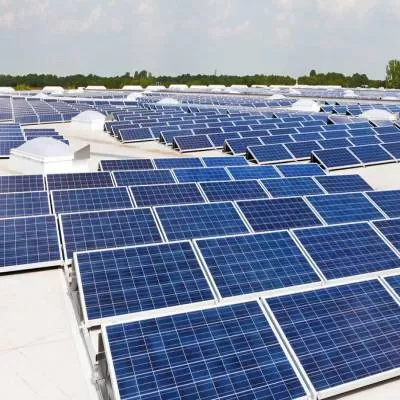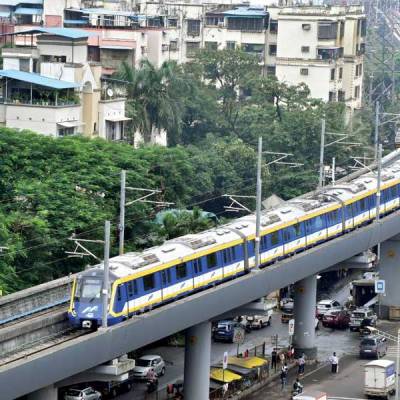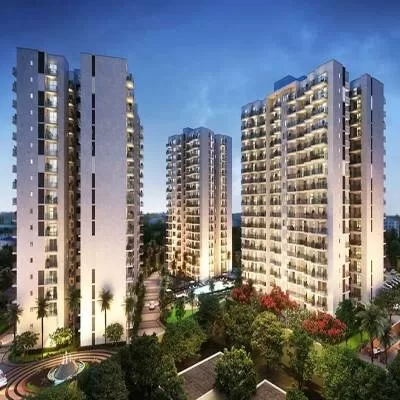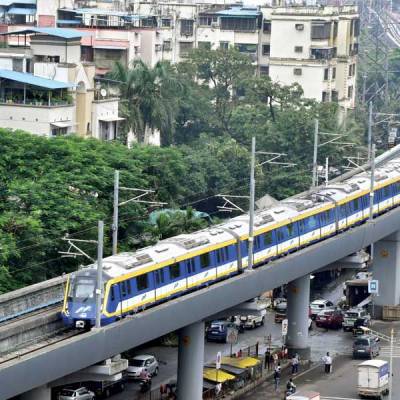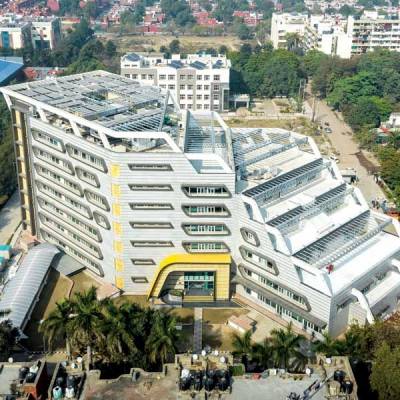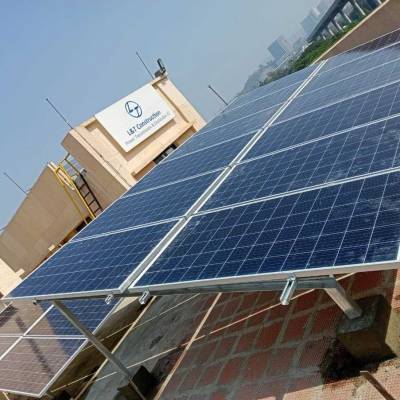- Home
- Real Estate
- What makes an office smart?
What makes an office smart?
Read full article
CW Gold Benefits
- Weekly Industry Updates
- Industry Feature Stories
- Premium Newsletter Access
- Building Material Prices (weekly) + trends/analysis
- Best Stories from our sister publications - Indian Cement Review, Equipment India, Infrastructure Today
- Sector focused Research Reports
- Sector Wise Updates (infrastructure, cement, equipment & construction) + trend analysis
- Exclusive text & video interviews
- Digital Delivery
- Financial Data for publically listed companies + Analysis
- Preconceptual Projects in the pipeline PAN India
Office smartness is popularly thought to come from cutting-edge technology from smart gadgets that contributes to workers’ comfort levels and productivity. However, “the smartness quotient of an office building starts with the base architectural design and, in particular, the design of its core and external skin,” explains Rahul Kumar, Principal Architect, Rajinder Kumar & Associates (RKA). “It is pointless to design inappropriately and expect technology to fill in lacunae such as the incorrect positioning of lifts or too many incorrectly placed corridors that impede contact and collaboration between people. Tech-enabled or tech-supporting furniture that contributes to worker wellness and technology that unifies electromechanical services on one platform for better monitoring and employee comfort follows accurate design.” Design agility One of the key design objectives in smart offices with large floor plates, say 40,000-50,000 sq ft, is to build in flexibility so that the space can suit the needs of different occupants who occupy the building over its lifecycle, adds Kumar. How to create smaller communities is another challenge, as is creating collaborative spaces for people to come together. At the Punjab National Bank building in Dwarka, New Delhi, an RKA project, an atrium with natural ventilation serves as a breakout area and a great place to meet and collaborate. Technology can help the dynamic allocation of office space. For instance, Schneider Electric offers a solution that uses traffic and occupancy data to monitor the utilisation of available spaces. If a demand for more space arises, the asset manager can rely on the solution to figure out if it is justified, and how it can be managed within the existing resources. ‘Enlighted’, a range of software-defined smart sensors from Siemens, collects and monitors real-time occupancy, light levels, temperature and energy usage. “Data collected from thousands of data points yields real-time intelligence, with which facility managers can reconfigure and adapt space to optimise use and address changing user needs,” elaborates Devidas Kulkarni, Head, Regional Solutions & Services, Smart Infrastructure, Siemens India. Open office The concept of a smart office has changed the typical office layout. Bipratip Dhar, Principal Architect, Epsilon Architecture, explains with an example: “The erstwhile office of a construction company in Kolkata’s congested business district wore the ‘departmental’ look of the 1980s, with narrow passages and corridors leading to gated zones. In contrast, we gave its new office in a quieter, more spacious location a modern open design.” Usually, hierarchy necessitates the creation of multiple enclosed spaces of different sizes to house personal workspaces and meeting rooms separated by corridors, which wastes space, according to Dhar. “Open offices tend to use space more efficiently, be more aesthetic and conducive to the entry of natural light and the use of connectivity technologies, making them comfortable and flexible.” Connectivity technologies play a large part in integrating the different divisions and subdivisions of an office, continues Dhar. For instance, at the headquarters and centralised laboratory of Suraksha Diagnostics & Eye Centre, Kolkata, technology connects the five floors of the building and branches across the region. From the functional perspective, “open spaces are more collaborative and conducive to co-locating employees,” says Sameer Joshi, Associate Vice-President, Marketing B2B, Godrej Interio. Any need for hierarchical division can be met by space segregation. In the aforementioned construction company, Dhar’s team located the executive area towards the north of the premise, taking advantage of the calming views of the waterside, and located the general workstations in the natural light-filled southern periphery. “In traditional offices, about 30 per cent of the space is kept for meeting rooms but as workstations in open offices are designed for collaborative working, this need has reduced,” notes Joshi. Sometimes, meetings are conducted in open spaces. Consequently, he estimates that open offices can help reduce the need for space by up to 30 per cent. Overall, the futuristic e-commerce and other emerging sectors are adopting open office designs as are start-ups, where many employees work from home or elsewhere outside the office environment, he adds. Smart furniture One of the drawbacks of an open office is that people can sometimes feel the lack of quiet spaces to work productively, observes Dhiren Gopal, Director, Featherlite. To fill this gap, Featherlite offers workstations that offer people privacy without burdening electromechanical systems as they use light and ventilation from the surroundings. As open spaces necessitate better acoustics, these ‘pods’ (as the workstations are called) are enclosed in aesthetic, soundproof walls made of frosted screens and/or acoustic panels composed of layers of perforated wood and polyester. Godrej Interio offers the Immerse Work Pod, a workstation designed as a personal space that allows the occupant to connect with the external office space through partial visual access. Visual access is critical in an office, says Kumar. “Retaining some visual access fosters communication and collaboration, a key objective in offices. Even in cafeterias, the preference is shifting from four to six to 12 to 14 seater tables, which encourage conversation and collaboration.” Gopal believes workstations designed for multiple users are less expensive than traditional offices and more space-efficient. For instance, Featherlite’s three-plus-three seater Genesis Multiply workstation doubles up as a micro-office and is suited to today’s office environment where average workers occupy a third less space than they did a decade ago. Recently, Featherlite released S-Pods for single users and D-Pods for meetings. Both products have motion sensors that enable fans and lights to turn on as soon as someone steps into the pod. Furniture + technology Technology and furniture converge in workstations such as Featherlite’s Genesis, which is fitted with electrical attachments for laptops, USB and LAN associations and a LED light. Featherlite’s range with inbuilt smart technologies includes products like Bluetooth-controlled height adjustable tables and soundproof telephone booths with plug-and-play electrical connections and ventilation sensors. “We’re seeing increasing demand in the market for technology-enabled smart furniture,” says Gopal. “Furniture that can incorporate wiring is preferred,” agrees Dhar. However, at Godrej Interio, the objective of the design team is not to just integrate technology into furniture. As Joshi explains, “Technology changes at a much faster pace than the furniture in which it is embedded. So, we support technology solutions with relevant modular furniture.” For instance, Godrej Interio’s collaborative audio-visual solutions are supported by pieces like the COLAB conference desk and range of AV-integrated meeting tables. Upbeat desk bases separate networking and power cables from the main furniture to give designers and end-users the flexibility to create and recreate layouts. Upbeat can meet the need for regular, high, mobile, meeting and conference tables. Pro-health furniture Health consciousness at the workplace is increasing, observes Kumar. “The practice of working while standing has become very common in Europe and, hence, this is factored into office design. However, furniture with hydraulic mechanisms tends to be more expensive. In India, we are seeing demand for taller desks with high bar stools or sit-stand desks with adjustable heights.” “Smart furniture, like standing desks, has become common,” agrees Dhar. “In future, we expect desks to understand people’s preferences and adjust to their needs, to further enhance productivity.” Featherlite has recently released pods with height -adjustable desks. Godrej Interio offers a motion chair that makes people move even when they are sitting to release the static pressure on the spine. “With the work environment getting increasingly stressful, more companies are willing to invest in softer, ergonomic furniture that is conducive to employee health,” opines Joshi. Personalised utilities In this age of smart offices, people have higher expectations from their workspaces, including the option to personalise HVAC and light settings for their workstations. RKA has implemented this level of personalisation in the 54-acre HCL Technologies campus in Noida. Signify’s Interact Office platform for large offices, launched in India early this year, enables employees to personalise the intensity and colour of light at their workstation, thereby enhancing their productivity, shares Sumit Padmakar Joshi, Vice-Chairman and Managing Director, Signify Innovations India (previously Philips Lighting). Siemens offers ‘Comfy’, a workplace experience app to bridge the gap between rising expectations of employees and the physical workplace. “Workers also expect lights, window shades and HVAC to adjust per occupancy and the weather and circadian lighting systems that mimic natural daylight,” adds Dhar. “We use network-connected lights powered by ethernet cables connected to sensors to empower clients to monitor temperature, light and occupancy. Thermostats, virtual reality cameras, smart switches, dimmers and relays are some other components of the smart lighting and HVAC systems making up a smart office.” To this, Kumar adds carbon dioxide air sensor levels that help monitor air quality in the office and the importance of green plants for contributing to worker wellbeing and office smartness. “Keeping wellbeing in mind, it is important to think of other ways of air circulation other than HVAC,” he says. “Chilling temperatures aren’t the best for the body so wherever possible we incorporate fans and other methods.Monitoring energyOne of the key ways to make an office smart is to enable building managers to use insights from sensors installed in the building to make intelligent decisions about a building’s energy consumption and occupancy levels, explains Padmakar Joshi. Signify’s Interact platform is one such connected lighting solution that delivers insights to help customers drive operational efficiencies and take more effective decisions to lower their electricity consumption, and track occupancy levels, breakdowns and repair and maintenance data. Smart offices often experience 5-20 per cent HVAC energy savings by preventing over-conditioning and widening temperature set points in unoccupied spaces, shares Kulkarni. Essentially, smart offices bring all electrical and mechanical services under a single platform, explains Prakasan TP, Chief Operating Officer, MEP Business, Sterling and Wilson. “Micro-level monitoring and energy audits is one big difference between a traditional office and a smart office. A second difference is that the HVAC architecture in traditional offices is largely discrete, consisting of VRVs, cassette ACs and indoor split ACs kept running with manual intervention without proper scheduling, which, in turn, results in energy wastage. But in smart offices, a centralised HVAC plant and structured cooling system cater to the heat load based on data fed by sensors, with variable drives, all of which are controlled by the building automation system to drive energy savings.” Ideally, the integrated building management system should use a smart, robust and open platform to connect disparate systems such as heating, ventilation, air-conditioning, mechanical, electrical, fire, security, lighting, etc, suggests Kulkarni. “A smart office monitors not only the amount of energy consumed but energy distribution and quality of energy being consumed,” adds Sanjay Sudhakaran, Vice-President, Digital Energy, Greater India Zone, Schneider Electric. “For instance, LED lighting and VRV drives are known to increase harmonics in a system, which adversely impacts its life. Monitoring helps detect, control and mitigate this adverse impact.” At the One Horizon Centre, a 24-storey (plus four basement) office building in Golf Course, Gurugram, a Sterling and Wilson project, the HVAC system, electrical system, diesel generator and lifts are integrated in a single command-and-control centre. The host of solutions that help manage the facility include systems for building automation, surveillance, energy monitoring, physical security, attendance, parking and visitor management and access control. Resource management Building analytics in a smart office extends to managing the resources available for users, such as conference rooms, says Sudhakaran. For instance, Schneider Electric’s solution helps people identify an available conference room of the right size for a meeting, and its navigation facility helps workers get there—a boon for new recruits in very large offices. “Discerning users expect to use technology such as an app for booking meeting rooms and they want meeting room screens that work seamlessly with their device,” observes Dhar. The practical impact of analytics technology lies is the greater wellbeing of office-users. “When we worked on the ITC Green Centre in Gurgaon, one of India’s first Platinum-rated green buildings, we asked employees what they felt was different about the building,” reveals Kumar. “‘I don’t get tired by 4 pm’ was a common response, which goes to show the positive impact of workplace smartness on employee well-being.” - CHARU BAHRI



